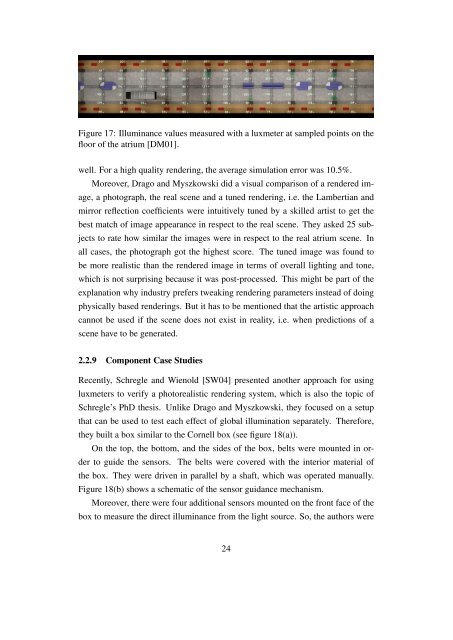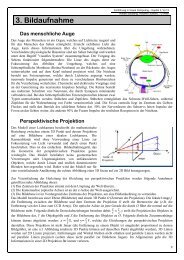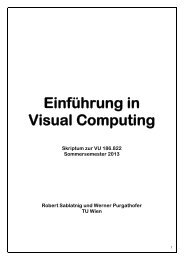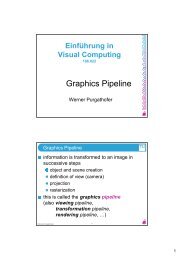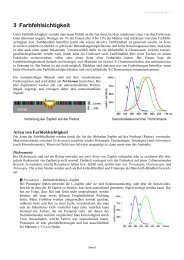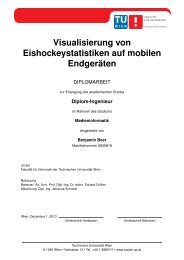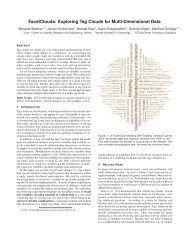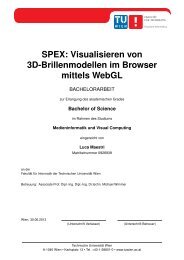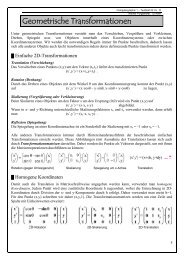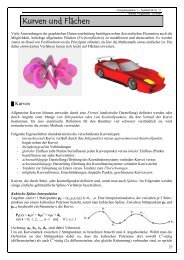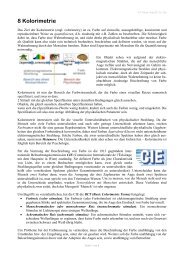Usability of Digital Cameras for Verifying Physically Based ...
Usability of Digital Cameras for Verifying Physically Based ...
Usability of Digital Cameras for Verifying Physically Based ...
You also want an ePaper? Increase the reach of your titles
YUMPU automatically turns print PDFs into web optimized ePapers that Google loves.
Figure 17: Illuminance values measured with a luxmeter at sampled points on the<br />
floor <strong>of</strong> the atrium [DM01].<br />
well. For a high quality rendering, the average simulation error was 10.5%.<br />
Moreover, Drago and Myszkowski did a visual comparison <strong>of</strong> a rendered im-<br />
age, a photograph, the real scene and a tuned rendering, i.e. the Lambertian and<br />
mirror reflection coefficients were intuitively tuned by a skilled artist to get the<br />
best match <strong>of</strong> image appearance in respect to the real scene. They asked 25 sub-<br />
jects to rate how similar the images were in respect to the real atrium scene. In<br />
all cases, the photograph got the highest score. The tuned image was found to<br />
be more realistic than the rendered image in terms <strong>of</strong> overall lighting and tone,<br />
which is not surprising because it was post-processed. This might be part <strong>of</strong> the<br />
explanation why industry prefers tweaking rendering parameters instead <strong>of</strong> doing<br />
physically based renderings. But it has to be mentioned that the artistic approach<br />
cannot be used if the scene does not exist in reality, i.e. when predictions <strong>of</strong> a<br />
scene have to be generated.<br />
2.2.9 Component Case Studies<br />
Recently, Schregle and Wienold [SW04] presented another approach <strong>for</strong> using<br />
luxmeters to verify a photorealistic rendering system, which is also the topic <strong>of</strong><br />
Schregle’s PhD thesis. Unlike Drago and Myszkowski, they focused on a setup<br />
that can be used to test each effect <strong>of</strong> global illumination separately. There<strong>for</strong>e,<br />
they built a box similar to the Cornell box (see figure 18(a)).<br />
On the top, the bottom, and the sides <strong>of</strong> the box, belts were mounted in or-<br />
der to guide the sensors. The belts were covered with the interior material <strong>of</strong><br />
the box. They were driven in parallel by a shaft, which was operated manually.<br />
Figure 18(b) shows a schematic <strong>of</strong> the sensor guidance mechanism.<br />
Moreover, there were four additional sensors mounted on the front face <strong>of</strong> the<br />
box to measure the direct illuminance from the light source. So, the authors were<br />
24


